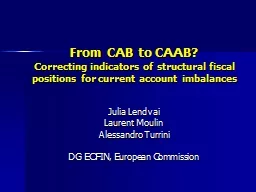

Alessandro Turrini DG ECFIN European Commission From CAB to CAAB Correcting indicators of structural fiscal positions for current account imbalances Motivation Before the crisis a number of EU countries have witnessed absorption booms and growing current account deficits as a result of ID: 780511
Download The PPT/PDF document "Julia Lendvai Laurent Moulin" is the property of its rightful owner. Permission is granted to download and print the materials on this web site for personal, non-commercial use only, and to display it on your personal computer provided you do not modify the materials and that you retain all copyright notices contained in the materials. By downloading content from our website, you accept the terms of this agreement.
Slide1
Julia LendvaiLaurent MoulinAlessandro TurriniDG ECFIN, European Commission
From CAB to CAAB?
Correcting indicators of structural fiscal positions for current account imbalances
Slide2MotivationBefore the crisis, a number of EU countries have witnessed absorption booms and growing current account deficits as a result of falling risk premia and rapid financial integration. At the same time, fiscal policy in those same countries has not been leaning against the wind effectively so as to contain boom-bust dynamics. This analysis shows that standard approaches
for adjusting budget balances for the cycle could miss part of the temporary revenues accruing during absorption booms
Illustrates a methodology to correct government budget balances for temporary elements linked both to
output cyclicality and to absorption booms (CAAB)
Uses DSGE models to assess the implications of
tageting
the CAAB during absorption booms for output stabilisation and the accumulation of external imbalances
Slide3Absorption booms, current account, fiscal policy
Slide4Absorptiom booms, current account, fiscal policySome stylised facts:Current accounts deteriorate during absorption booms, improving afterwards;Government budget balance improves during the boom, falling afterwards;CAB broadly constant during the boom, falling afterwards;Strong growth of indirect revenues/GDP during the boom ;
Apparent revenue
elasticities
growing
during
the boom,
falling
afterwaeds
Slide5Linking current accounts and structural indicators of fiscal policy (I)CAB approach assumes that revenues are linked to outputWhile this is the case for direct taxes, indirect taxes are levied on imports but not on exports, i.e., they are linked to absorptionFor the above reason, and since output and absorption are imperfectly correlated, the CAB may miss temporary cyclical components of the budget during absorption booms and busts
Slide6Linking current accounts and structural indicators of fiscal policy (II)The CAB is built on a well-known benchmark for computing structural revenues and expenditures, i.e., output equal to potentialAn equally obvious candidate is not available for defining a benchmark for absorptionApproach taken: link benchmarks for absorption to benchmarks for current accounts.
C
urrent account balances in line with fundamentals (“current account norms”).
Slide7From CAB to CAABCABt = (b/y)t – λ
ygap
t
CAAB
t
=
(
b/y
)
t
–
β
t
ygap
t
–
γ
t
agap
t
,
β
t
=
λ
t
-γ
t
.
agap
t
=
[(
a
t
– a*
t
)
/y*
t
]
,
a*
t
= y*
t
– ca*
t
+
it
t
.
Slide8From CAB to CAABThe current account norm ca* is estimated following the approach developed in Chinn and Prasad (2004) and by the IMF CGER (Lee et al., 2008). Prediction from pooled cross-section/time series regressionsSample: 60 advanced and emerging economies, 1970-2010Specification: General government budget balance/GDP ratio (+) Old-age dependency ratio (-)Real GDP per capita at PPP (+)
Real GDP per capita growth (-)
Net foreign asset/GDP ratio (+)
Oil balance (+)
Slide9Does CAB or CAABmake a difference? (I)
Difference between CAAB and
CAB,
selected
euro-area
countries
(
percent
of
GDP)
Slide10Does CAB or CAABmake a difference? (II)
Difference between CAAB and
CAB
for
selected New Member
States
(
percent
of
GDP)
Slide11Does CAB or CAAB make a difference? (III)
Difference between CAAB and
CAB
for
selected New Member
States
NFA-stabilisation approach
(
percent
of
GDP)
Slide12Does targeting the CAABmake a difference? (I)DSGE model simulations help assessing the extent to which targeting the CAAB rather than the CAB can make a difference
for fiscal prudence and
preventing
imbalances
Simulation
with
QUEST III
Model set up
Small open
economy
,
fixed
XXR
C
alibrated
to
average Baltic economy
Shocks
A): Baseline: 500
bp
.
reduction
in
risk
premium
in
2001
B): A)+ CAB=0
since
2005 (max 4% GDP)
C): A) + CAAB==0
since
2004 (max 7% GDP)
Slide13Does targeting the CAABmake a difference? (II)
Targeting CAB or CAAB balance during absorption booms: DSGE model simulations
Slide14Concluding remarksThe standard EU method for adjusting budget balances during the cycle may miss some temporary revenue components during absorption boom and busts A relatively straightforward modification of the CAB that also takes into account the fact indirect taxes are linked to absorption (CAAB) could be a useful counter-check in assessing the structural fiscal position of countries Taking into account the link between temporary revenues and absorption in constructing indicators for structural fiscal balances would contribute to Fiscal prudence during absorption booms
strengthening the contribution of the fiscal balance in preventing external imbalances